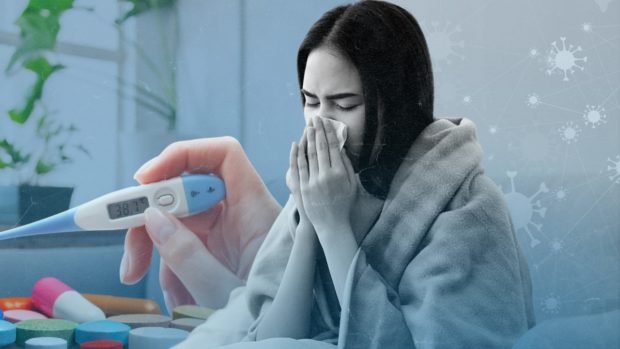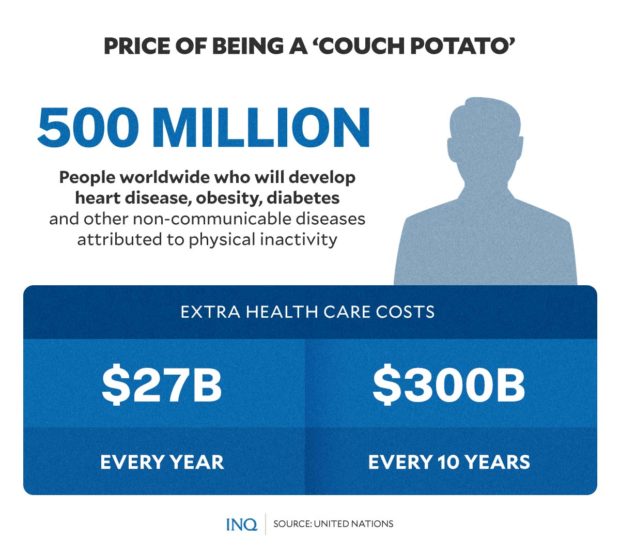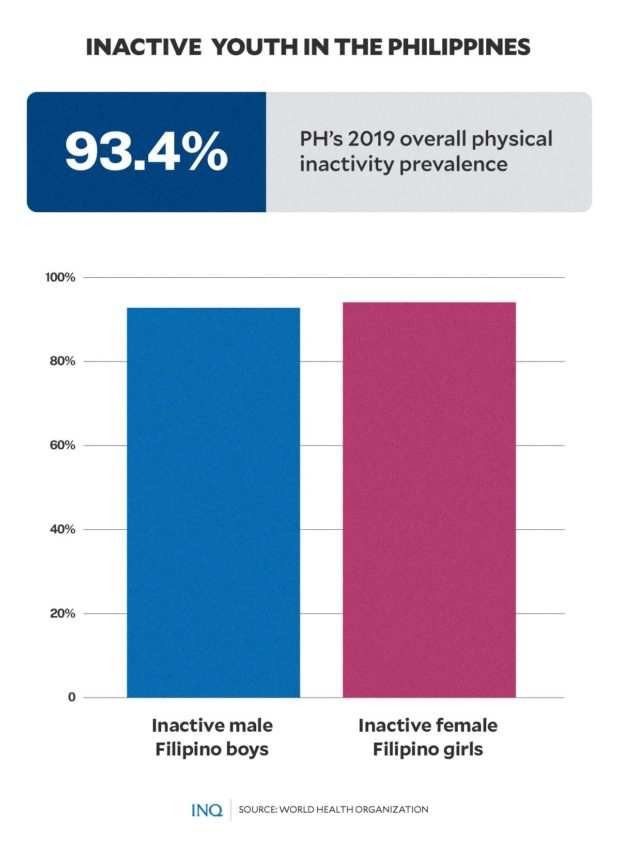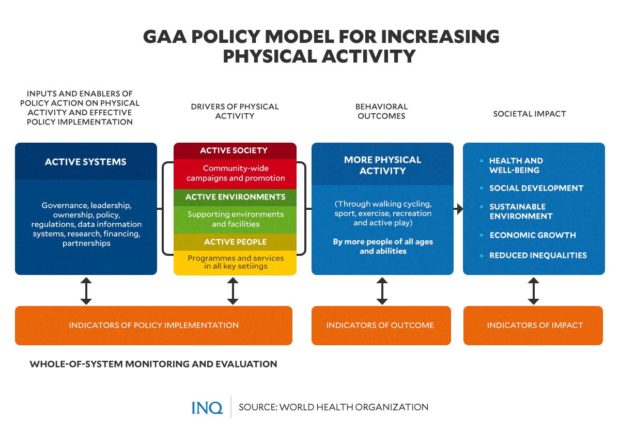In first ever report on physical inactivity, WHO warns of diseases, costs
MANILA, Philippines—The World Health Organization (WHO) and United Nations (UN) warned the public of the negative health implications and economic burden of physical inactivity following the release of the first-ever global report on physical activity.
The Global Status Report on physical activity 2022 released this week found that 81 percent of adolescents and 2.75 percent of adults worldwide “currently do not meet WHO’s recommended levels of physical activity.”
In 2019, WHO found that the Philippines had an overall “physical inactivity prevalence” of 93.4 percent. The country ranked second in the world—among 146 countries—with the most physically inactive adolescents next to South Korea, with an overall rate of 94.2 percent.
READ: WHO: PH youths 2nd most ‘inactive,’ next to S. Koreans
WHO cautioned that this has an impact not only on individuals and their families over their lifespan but also on health services and society as a whole.
“Physical inactivity contributes not only to missed opportunities for children and adults to have better health but also to the increasing burden of morbidity and mortality that results from non-communicable diseases (NCDs),” WHO said in the report.
“About 7–8% of all cases of cardiovascular disease, depression, and dementia, and about 5% of type-2 diabetes cases, could be prevented if people were more active.”
Based on the organization’s recommended levels of physical activity, the ideal amounts of time spent on physical activity are:
- for pregnant and postpartum women: 150 minutes per week;
- for adults and older adults: 150 to 300 minutes per week;
- for children and adolescents: 60 minutes per day;
- for everyone who can: over 300 minutes per week.
Adults were also advised to allot at least two days per week for muscle-strengthening activities and at least three days a week for multicomponent activities for balance and strength for older adults.
The WHO data showed that those who meet the recommended levels of activity have a 20 percent to 30 percent reduced risk of premature death.
“Physical activity also benefits mental health, including prevention of cognitive decline and symptoms of depression and anxiety, and improves children’s educational attainment. It can also contribute to the maintenance of healthy weight and general well-being,” it added.
Economic burden
Citing data from the WHO report, the UN said that almost 500 million people worldwide would develop heart disease, obesity, diabetes, or other non-communicable diseases (NCDs) attributable to physical inactivity.
The price of inaction and staying on the couch, WHO and UN stressed, will be severe, amounting to around US$27 billion every year—or around US$300 billion—in extra healthcare costs.
“Globally, almost 500 million (499,208 million) new cases of preventable NCDs will occur between 2020–2030, incurring treatment costs of just over US$ 300 billion (INT$ 524 billion) or around US$ 27 billion (INT$ 48 billion) annually if there is no change in the current prevalence of physical inactivity,” the report stated.
WHO said the burden of new cases “will largely fall on lower- and upper-middle-income countries,” with the Western Pacific Region—where the Philippines is located—predicted to be hardest hit.
A 2019 report by WHO and the UN Development Programme (UNDP) found that NCDs account for 68 percent of all deaths in the Philippines. The economic cost of NCDs to the Philippine economy is PHP 756.5 billion per year, equivalent to 4.8% of the country’s annual gross domestic product.
This cost includes the direct costs of NCDs associated with treatment, care, and social security provision but also indirect costs that arise from the loss of workforce and reduced productivity.
“These estimates show that society is paying the price for not acting to reduce levels of physical inactivity,” WHO said in its report.
Time to move
“We need more countries to scale up implementation of policies to support people to be more active through walking, cycling, sport, and other physical activity”, said Tedros Adhanom Ghebreyesus, WHO director-general, in a statement.
“The benefits are huge, not only for the physical and mental health of individuals, but also for societies, environments, and economies. […] We hope countries and partners will use this report to build more active, healthier, and fairer societies for all,” Ghebreyesus added.
To help countries improve and increase physical activity, WHO has set out 20 policy recommendations as part of its global action plan on physical activity 2018-2030 (GAPPA).
“Tracking countries’ progress in implementing GAPPA-recommended policy actions is essential to provide an assessment of global progress towards achieving the global target of a 15% reduction in physical inactivity by 2030,” WHO said in the report.
“Global monitoring is important because it provides standard, robust, and comparable data to inform decision-makers and support global, regional, and national priority setting and resource allocation.”
The GAPPA policy model for increasing physical activity includes recommendations to increase levels of participation across four strategic policy areas:
- Active societies: these require sustained, community-wide communication campaigns using diverse mass-media communication channels and inclusive messages and images (tailored to communities) to effectively reach large numbers of people to inform, motivate and engage them in more physical activity.
- Active environments: these require safe, affordable places and spaces that invite, support, and enable people of all ages and abilities to be active in different ways. For example, green public open spaces provide places for sport and play, while separated cycle lanes invite more people to cycle for short trips.
- Active people: these require access to programs, services, and equipment that provide affordable, enjoyable, and inclusive opportunities for all people to be active where they live, work and play, including in schools, at work, in parks, and in other community venues.
- Active systems: these require governance and policy enablers that provide leadership, relevant policy, legislative and regulatory frameworks, multi-sectoral coordination and partnerships; a trained workforce; and information systems to support policy implementation and evaluation.
The policy recommendations include the creation of safer roads to encourage more biking and walking. It also urged countries to provide more programs and opportunities for physical activity in key settings, such as child care, schools, primary health care, and the workplace.
“We are missing globally approved indicators to measure access to parks, cycle lanes, foot paths – even though we know that data do exist in some countries”, said Fiona Bull, head of WHO’s Physical Activity Unit.
“Consequently, we cannot report or track the global provision of infrastructure that will facilitate increases in physical activity”.
“It can be a vicious circle, no indicator and no data leads to no tracking and no accountability, and then too often, to no policy and no investment. What gets measured gets done, and we have some way to go to comprehensively and robustly track national actions on physical activity.”
The UN said the Global Status Report on Physical Activity 2022 calls for countries to “prioritize a fitness boost, as key to improving health and tackling NCDs, integrate physical activity into all relevant policies, and develop tools, guidance, and training.”
“It is good for public health and makes economic sense to promote more physical activity for everyone,” said Dr. Ruediger Krech, WHO director in the Department of Health Promotion.
“We need to facilitate inclusive programmes for physical activity for all and ensure people have easier access to them. This report issues a clear call to all countries for stronger and accelerated action by all relevant stakeholders working better together to achieve the global target of a 15% reduction in the prevalence of physical inactivity by 2030.”



